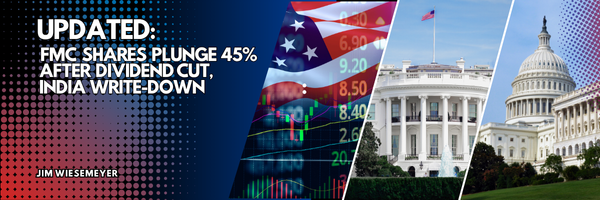
UPDATED: FMC Shares Plunge 45% After Dividend Cut, India Write-Down
Investors flee as ag-chemical giant slashes payout, warns of margin pressure and weak demand
FMC Corporation shares cratered more than 45% on Thursday after the Philadelphia-based crop-protection company announced a steep dividend cut, sizable asset write-downs, and weaker full-year guidance — triggering one of the sharpest single-day selloffs in the firm’s history.
The company reduced its quarterly dividend from 48 cents to just 8 cents per share, citing the need to conserve cash amid soft global demand and elevated debt. FMC also disclosed plans to sell its India commercial business, recording impairments and related charges exceeding $500 million. The exit will narrow FMC’s geographic footprint but is aimed at refocusing resources on higher-margin core markets in North and Latin America.
According to Barron’s, the dividend reduction “shocked income-oriented investors” who had relied on FMC’s steady payouts, while Benzinga, a Detroit-based financial media and data company, reported that the India divestiture “signals ongoing structural headwinds in emerging markets.” The company’s update also confirmed that 2025 revenue is expected to fall slightly, to between $4.08 billion and $4.28 billion, with adjusted EBITDA of $870 million to $950 million — barely above last year’s depressed levels.
| Analysts noted that the latest results underscore FMC’s exposure to the global down-cycle in crop-chemicals, where lower farm incomes and high inventories have eroded pricing power. With net debt estimated near five times EBITDA, leverage concerns are mounting, and the company’s decision to redirect cash from dividends to debt repayment reflects those pressures. Quiver Quantitative data show retail investors dumping the stock en masse as the news broke, pushing FMC’s market capitalization below $3 billion. The selloff erased nearly all gains made since the firm’s 2020 pandemic-era lows. |
Still, some analysts see potential recovery if management executes on its new-product pipeline and global crop prices stabilize. FMC’s “growth actives” in insecticides and biologicals could eventually restore margins, though the turnaround will take time.
For now, the message from investors is unmistakable: until FMC stabilizes its balance sheet and proves its core markets can recover, confidence — and capital — will remain scarce.
| FMC Slashes Dividend 85% Amid India Write-Down, Restructuring Push Company lowers full-year guidance; CEO Brondeau outlines cost-cutting and manufacturing overhaul as market pressures intensify FMC Corporation reported third-quarter 2025 revenue of $542 million, down 49% year-over-year, as the agricultural chemical maker absorbed a $419 million negative impact from its India business, which is being prepared for sale. Excluding India, revenue came in at $961 million, a 4% decline from the prior year. Adjusted EBITDA rose 17% to $236 million, with earnings per share up 30% to $0.89, but management cut full-year guidance sharply and slashed the quarterly dividend by 85%. Free cash flow is now expected between –$200 million and $0, reflecting liquidity constraints and pricing pressures across key markets. India Exit and $510 Million in ChargesChief Financial Officer Andrew Sandifer said FMC recorded $419 million in negative revenue and $510 million in charges and write-downs related to the India business. The company reversed earlier sales, accepted product returns, and provided price credits to clear bloated channel inventory. The write-down brought the carrying value of the Indian unit to $450 million, which management said aligns with estimated fair market value. CEO Pierre Brondeau emphasized that buyer interest is strong, noting “a high volume of inbound inquiries,” mostly from local firms. Latin America Weakness, Generic CompetitionBrondeau attributed much of the quarter’s sales shortfall to credit constraints in Brazil and Argentina and price pressure from generic competitors. “We were unwilling to sell full volumes to customers with credit risk or lower prices to generic levels,” he said. FMC also pointed to regulatory differences fueling generics’ growth: registering a product in Brazil costs about $70,000, compared to $1 million in the U.S. or EU. The company is expanding its direct sales route to large soybean and corn growers in Brazil, with “over 300 new customers invoiced to date.” Outlook: Cost-Cutting and Manufacturing OverhaulFMC expects Q4 sales (excluding India) between $1.12 billion and $1.22 billion, with adjusted EBITDA of $265 million–$305 million, implying a 7% decline year-over-year on a like-for-like basis. The company now forecasts full-year revenue between $3.92 billion and $4.02 billion, EBITDA of $830 million–$870 million, and EPS of $2.92–$3.14. Brondeau announced a strategic review of FMC’s manufacturing footprint, with plans to exit high-cost plants and transition production to lower-cost sources by 2026. Two active ingredients have already been moved to cheaper facilities. He said FMC will “become a cost-competitive company capable of competing with generics” while continuing to invest in IP-protected products such as Isoflex™ Active and fluindapyr. Financial Pressures and Debt StrategySandifer said the company ended the quarter with $4.5 billion in gross debt and $498 million in cash, yielding a net debt-to-EBITDA ratio of 4.5x — close to its covenant ceiling. To conserve liquidity, FMC’s board reduced the quarterly dividend to $0.08 per share, freeing up $250 million annually for debt repayment. He added that all free cash flow beyond the reduced dividend will go toward deleveraging until leverage returns to “healthier investment-grade levels.” FMC is also negotiating amended credit facility covenants to “provide additional flexibility.” CEO Outlook: 2026 Uncertainty, 2028 VisionBrondeau cautioned that formal 2026 guidance will come in February, citing tariff and demand uncertainty. However, he outlined a long-term path centered on four new active ingredients and a growing biologicals portfolio, expected to drive growth by 2028. “2026 will be a difficult year as we readjust the company,” Brondeau acknowledged, “but by 2028, FMC will look more like the company we were in 2018—leaner, stronger, and innovation-driven.” He reaffirmed FMC’s commitment to innovation partnerships, noting ongoing collaborations such as with Corteva on fluindapyr, and emphasized that India is the only market targeted for sale within Asia. Key TakeawaysQ3 revenue down 49% YoY due to India write-down; excluding India, revenue down 4%.Adjusted EBITDA +17% YoY; EPS +30% to $0.89.Dividend cut 85% to $0.08/share; FCF outlook –$200M to $0.$510M in charges tied to India exit; business valued at $450M.Strategic manufacturing review underway; cost exits planned through 2026.2026 seen as a transition year toward 2028 innovation-led recovery. |


